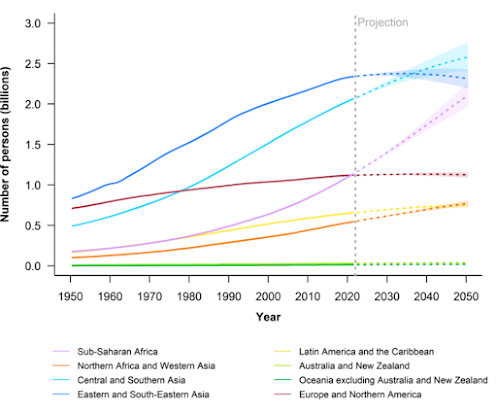World Population Prospects, 2022.
According to the report of World Population Prospects, 2022.
·
World
population will likely increase by around 8.5 billion in 2030, 9.7 billion in
2050, and 10.4 billion in 2100.
·
In
2021, the average fertility of the world's population stood at 2.3 births per
woman over a lifetime, having fallen from five births per woman in 1950. Global
fertility is projected to decline to 2.1 births per woman by 2050.
Want to learn "Global Poverty"? Click here
Global population size
and annual growth rate: estimates, 1950-2022, and medium scenario with 95 percent
prediction intervals, 2022-2050
· Population growth is caused in part by declining levels of
mortality, as reflected in increased levels of life expectancy at birth.
Globally, life expectancy reached 72.8 years in 2019, an increase of almost 9
years since 1990. Further reductions in mortality are projected to result in
average longevity of around 77.2 years globally in 2050.
Global total fertility rate (Panel A) and number of
births (Panel B): estimates, 1950-2021, and medium scenario with 95 percent
prediction intervals, 2022-2050
· In 2022, the two most
populous regions were both in Asia: Southern and South-eastern Asia (China and
India). Both making 45% of the Global population in China with 2.3 billion people (29 percent of the
global population) and in India with 2.1 billion (26 percent).
Population estimates, 1950-2022, and projections with
95 percent prediction intervals, 2022-2050, by region
· India is projected to surpass China as the
world's most populous country by 2023.
· Pakistan will remain the fifth most populated country in the world by 2050 (as of 2022).
Rankings of the
world's ten most populous countries, 1990 and 2022, and medium scenario, 2050
(numbers in parentheses refer to total population in millions)
· The global population aged 65 years or above is
projected to rise from 10 percent in 2022 to 16 percent in 2050.
· For
high-income countries between 2000 and 2020, the contribution of international
migration to population growth
(net inflow of 80.5 million) exceeded the balance of births over deaths (66.2
million). Over the next few decades, migration will be the sole driver of
population growth in high-income countries. By contrast, for the foreseeable
future, population increase in low-income and lower-middle-income countries
will continue to be driven by an excess of births over deaths.
The proportion of youth aged 12 to 17 years in 2021, by
the upper secondary education completion rate, 2006-2020
Population growth rate, 2015-2020, by the proportion
of the population living below the international poverty line, 2003-2021
· Globally, the world will count slightly more men (50.3 percent) than
women (49.7 percent) in 2022. This figure is projected to slowly invert over the century. By 2050, it is expected that the number of women
will equal the number of men.
Reference:
https://www.un.org/development/desa/pd/content/World-Population-Prospects-2022







Comments
Post a Comment